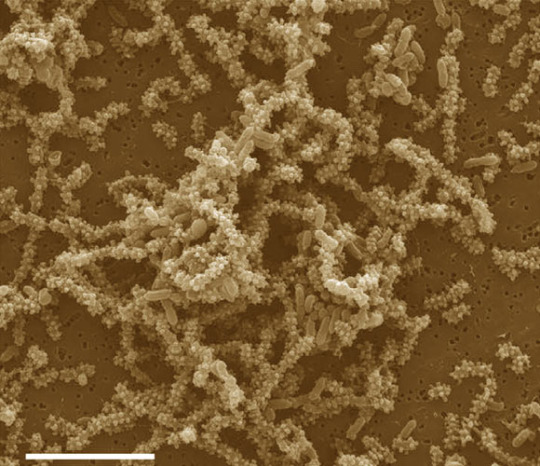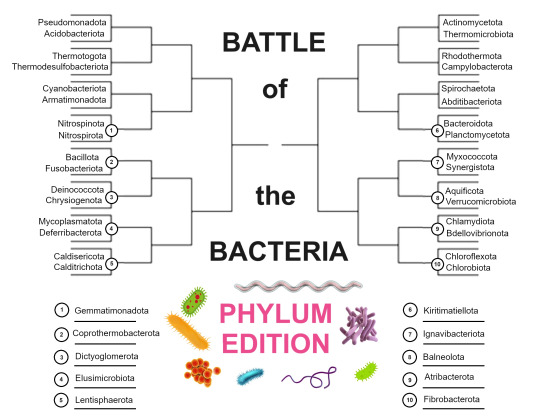#chlorobiota
Text
Chloroflexota vs. Chlorobiota
Chloroflexota propaganda here
Chlorobiota propaganda here


24 notes
·
View notes
Text
Chlorobiota
Group: Hydrobacteria; FCB Group
Gram-stain: Negative
Etymology: For Chlorobium limicola. From the Greek "chloros", meaning "yellowish green", and "bios", meaning "life", because the bacteria in this phylum are green.
About: Known as the "green sulfur bacteria", Chlorobiota are sulfur-oxidizing photoautolithotrophs that photosynthesize using green bacteriochlorophylls. They are obligate anaerobes, and thrive in anoxic environments with high concentrations of sulfide. This includes hot springs, as well as sediments, and some freshwater lakes and ponds. They use compounds such as sulfide, thiosulfate, and elemental sulfur as electron donors, and are carbon-fixing. In certain aquatic environments, they may be responsible for up to 83% of carbon fixation annually, making them a critical member of the ecosystem. Some Chlorobiota also fix nitrogen.
Thanks to their special light-harvesting antennae adaptations, Chlorobiota is a phylum of extremely optimized phototrophs. They can grow in very diminished light conditions where no other photosynthetic bacteria can survive. A single Chlorobiota cell may contain over 50 million molecules of bacteriochlorophyll, spread among their various antennae, in structures called "chlorosomes". The cell shape is therefore also optimized for photosynthesis, since Chlorobiota are able to stick out antennae like tiny roots or branches, maximizing exposure to light.
Some Chlorobiota are unique for their ability to reproduce via ternary fission. This is in contrast to binary fission, the method used by most bacteria: instead of dividing in half, in ternary fission the nucleus splits into three. The cytoplasm then separates to create three daughter cells.
Chlorobiota are non-motile (i.e. incapable of movement), except for the species Chloroherpeton thalassium, who move by flexing and gliding. Despite many similarities in biochemistry and function, Chlorobiota are not closely related to the other major phyla of photosynthetic bacteria, such as Chloroflexota and Cyanobacteriota.

11 notes
·
View notes
Text
Phylum Bracket Announcement!

42 bacterial phyla, from two sources: Oren & Garrity (2021), and the list of recognized bacterial phyla under the ICNP as of February 2024. The Oren & Garrity list is more expansive, as it includes bacterial phyla that have been well studied, but not cultivated in the lab, while the ICNP restricts itself to bacteria that have been successfully cultured. 36 phyla were on both lists, 4 were exclusive to Oren & Garrity, and 2 were exclusive to the ICNP. Two phyla from the Oren & Garrity list were excluded for not being bacteria, as the list was of prokaryotic phyla generally.
The first round will be between 32 of the phyla, while ten sit out. Then the second round, which will be called round 1.5, will pair ten of the winners from the first round against those ten. Thus, after round 1.5, there will be 16 bacterial phyla remaining, and the tournament proceeds as is standard from there.
Here is a list of the phyla, organized (roughly) by clade and superphylum. Clades/superphyla are in bold and phylum names are in italics for clarity.
Terrabacteria
Abditibacteriota
Actinomycetota
Armatimonadota
Bacillota
Chloroflexota
Cyanobacteria
Mycoplasmatota
Thermomicrobiota
Hydrobacteria
Elusimicrobiota
Spirochaetota
Proteobacteria
Acidobacteriota
Aquificota
Bdellovibrionota
Campylobacterota
Chrysiogenota
Deferribacterota
Myxococcota
Nitrospinota
Nitrospirota
Pseudomonadota
Thermodesulfobacteriota
PVC Group
Chlamydiota
Lentisphaerota
Kirimatiellota
Planctomycetota
Verrucomicrobiota
FCB Group
Bacteroidota
Balneolota
Chlorobiota
Fibrobacterota
Gemmatimonadota
Ignavibacteriota
Rhodothermota
Thermotogida
Synergistetes
Atribacterota
Synergistota
Thermocalda
Caldisericota
Calditrichota
Coprothermobacterota
Dictyoglomerota
Thermotogota
Other
Deinococcota
Fusobacteriota
Propaganda is still underway, but look out for an announcement of the first battles soon! I am planning to do round 1 in two parts over two weeks, with 8 battles in each week. Get ready: the girls are fighting !!!
66 notes
·
View notes
Text
Round 1 is Complete!

In the second part of the first round, Actinomycetota, Rhodothermota, Spirochaetota, Planctomycetota, Myxococcota, Verrucomicrobiota, Bdellovibrionota and Chloroflexota were victorious! We will be saying goodbye to Thermomicrobiota, Campylobacterota, Abditibacterota, Bacteroidota, Synergistota, Chlamydiota, and Chlorobiota.
The list of bacteria that will proceed to Round 2 will be determined after Round 1.5, which will consist of the following 10 battles!
Nitrospirota vs. Gemmatimonadota
Bacillota vs. Coprothermobacterota
Deinococcota vs. Dictyoglomerota
Mycoplasmatota va. Elusimicrobiota
Caldisericota vs. Lentisphaerota
Planctomycetota vs. Kiritimatiellota
Myxococcota vs. Ignavibacteriota
Verrucomicrobiota vs. Balneolota
Bdellovibrionota vs. Atribacterota
Chloroflexota vs. Fibrobacterota
I have a lot of propaganda left to write for the new bacteria in this round, so I expect it to be about a week before that round is ready.
THANK YOU all for voting! The most popular poll this round got over 200 votes, and I am so happy to see that kind of engagement over microbiology. I myself have learned SO MUCH about bacteria through this project and hope to learn more about the field afterwards... honestly this whole tumblr taxonomy community has been really inspiring!
THANK YOU as well to: @0ctogus! They proof-read basically ALL of the propaganda that hits your dash (with the exception of some early examples), and were generally super helpful as a source of quality-control and peer-review, from someone who has a much better knowledge of biology than I. It didn't feel right to finish this round off without mentioning their contributions!
And that concludes Round 1! See you all soon with more Bacteria Facts.
16 notes
·
View notes
Text
Chloroflexota
Group: Terrabacteria
Gram-stain: Varied
Etymology: For Chloroflexus aurantiacus. From the Greek "chloros", meaning "yellowish green", and Latin "flexus", meaning "bending", for their green color.
About: Chloroflexota, known for containing the "green non-sulfur bacteria", is a highly diverse and ubiquitous phylum. They exhibit a variety of oxygen tolerances, and may be aerobic, anaerobic, or somewhere in between. Members of Chloroflexota can be thermophiles or mesophiles, living in a range of environments such as hot springs, sea-floor sediments, soil, and anaerobic sludge bioreactors. They are largely chemoheteroorganotrophic, with several members also capable of photoautotrophy. Despite their prevalence, Chloroflexota have limited cultivability, and are therefore still quite understudied. The species Thermoflexus hugenholtzii are especially picky, with the narrowest growth-temperature range (in culture) of any known prokaryote (67.5°- 75° C).
On the Gram stain, Chloroflexota show varied results. Most are monoderms, having only one cell membrane, but many still stain gram-negative. This is due to the unique composition of their cell walls (one factor of which is the higher presence of a molecule called "pseudopeptidoglycan", rather than being primarily peptidoglycan). There are also plenty of gram-positive, spore-producing Chloroflexota. These share similarities with Actinomycetota and fungi, since they produce spores using hyphae, and form mycelium.

The name "green non-sulfur bacteria" is associated with the family Chloroflexaceae, in the order Chloroflexales. The Chloroflexales are known as the "filamentous anoxygenic phototrophic bacteria", or FAPs, for their style of photosynthesis that does not produce oxygen (in contrast to Cyanobacteriota and plants). There are "red FAPs" and "green FAPs", with the green FAPs constituting the green non-sulfur bacteria, in the family Chloroflexaceae.
Green non-sulfur bacteria share many similarities with their counterparts, the green sulfur bacteria (Chlorobiota), despite being distantly related. Both groups form the same antennae structures, filled with bacteriochlorophyll-containing chlorosomes that color them green. Chloroflexaceae, however, are not primarily photosynthetic. Instead, they are facultative anaerobes who tend to use a chemoheterotrophic metabolism in the presence of oxygen, and a photoautotrophic metabolism in its absence.
Another interesting family of Chloroflexota are the Dehalococcoidaceae, because they are involved in halogen-cycling. The bacteria are organohalide-respiring (halogens are reactive elements belonging to the group containing fluorine and chlorine, and an organohalide is an organic compound with a carbon-halogen bond). Thanks to this style of respiration, Dehalococcoidaceae are able to thrive in chlorinated environments. This makes them useful in the bioremediation of chlorine-contaminated ecosystems. Also, they can produce metabolites that smell like garlic.
10 notes
·
View notes